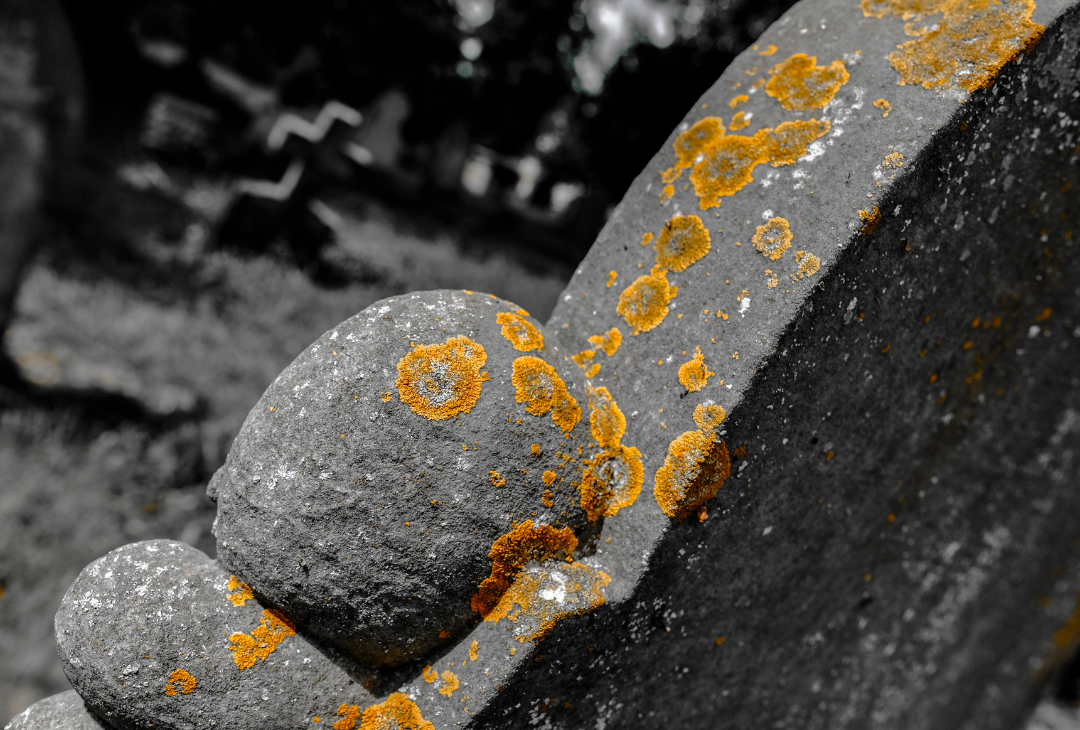Cemetery Lichen
by Christy Howard
Field Note #14
Image: Detailed view of old lichen on an ancient gravestone by Nickbeer
The days are getting shorter, the leaves are changing and falling, and a chill is in the air. It is Autumn in the Gallatin Valley. It is also the perfect time to visit your local graveyard. You might not always think of cemeteries as being full of life, but they have a surprising amount of biodiversity in their little ecosystems. At Sunset Hills Cemetery in Bozeman you can find Douglas firs, maples, lilacs, and chokecherries to name a few of the trees and bushes. There are rabbits, an urban deer herd, songbirds, and a lot of squirrels. So many squirrels. There are even flowers for many types of pollinators. Then, if you look closely, you can find the complex and diverse world of cemetery lichens.
As you wander through your local cemetery, you may notice yellow or orange crust on some of the tombstones. Sometimes it can also be chalky white, pale green, or even black. They may look crusty but if you look a little closer you will see leafy lobes. These are crustose or ‘crusty’ lichens. Many of them might be as old as the dates on the gravestones
What is a lichen exactly? Lichens are composed of a main fungi, a group of algae or cyanobacteria, and a small assortment of smaller fungi and bacteria. The fungi offers structure and protection, while the algae or cyanobacteria provide food. Lichens are found on every continent, in every climate, and every altitude on Earth. They have been to space, can withstand radiation, and more recently scientists have grown them in conditions like those on Mars.
While there are three main types of lichen (crustose, foliose, and fruticose), crustose lichens compose 75% of all lichen species. You might think of them as pioneers in a way. After a rock is exposed to our atmosphere spores of many different types of organisms search out little crevices to try and make a home. However, most of them die due to the extreme conditions of living on a rock. Not crustose lichens though. They are extremophiles and don’t need a lot to survive. Just like the tardigrades (water bears) and nematodes you can find living in them.
First, they trap dust which helps with soil formation and gives them something to adhere to. Secondly, they can make food in a variety of ways depending on the algae or bacteria living inside of them. Some lichens convert nitrogen in the air into nitrates that help them grow. Others get their nutrients from rain, animal droppings, and photosynthesis. Rain can then leach these nutrients and make it available to plants in the immediate area. All of this helps expand their ecosystem. Finally, Crustose lichens are also very difficult to remove once they have made a home somewhere.
What is special about cemetery lichens? Some lichens have only been found in cemeteries. There are some that contain chemical compounds found hardly anywhere else on Earth. Lichens are also incredibly diverse. Lichens that grow on sunny sides are different than those found in the shade. Monuments under trees can collect water from dripping branches allowing for certain lichens to grow bigger than others. The color of the lichen can protect them from too much sunlight or low temperatures. Or it can tell you what it gets nutrients from. For example, Sunburst lichens like to grow where animals urinate and can be found on markers down on the ground. Caloplaca flavescens or jewel lichen really likes limestone and marble as well as places where birds perch and leave bird droppings.
Lichens are important as they are a great indicator of clean air as they are sensitive to environmental changes. As urban lichens, scientists have been able to gauge air quality based on the lichens found in cemeteries. Through Lichenometry, or lichen dating, scientists may be able to date the rocks that they colonize as most crustose lichens are incredibly slow growers. They also play an important role in the weathering of rocks.
So, the next time you are at your local cemetery look closely. You might find some foliose lichens growing on tree trunks or a new crustose lichen that has a pattern in the center that looks like dried out mud. You’ll find the lichens on the older gravestones. They like marble, limestone, and sandstone. More porous stones will have more lichen. Polished stone like granite is a bit harder to adhere to, but even over time the lichens might move in.
Cemeteries are for more than just the dead. You may just need to look a little bit closer.
Happy Halloween!
More Lichen Reads:

